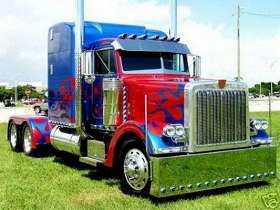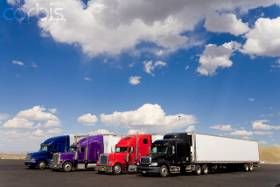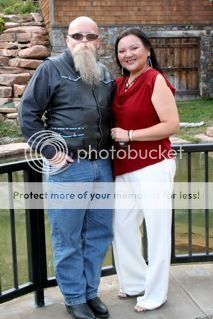Double Clutch Vs. Clutch
Topic 1634 | Page 1
An instructor at the school I just finished told us to try putting a paper or plastic cup under one end of a 12" long piece of wood and to then practice tapping the "Clutch" pedal without crushing the cup was the goal, the timing is to just try and get the rhythm down clutch once to get out of gear clutch again to slide into gear I added a Plunger to the floor beside my chair to help too. I may have seen this elsewhere here as well in another thread, but can't remember where so I can't paste a link for ya.
Tom, you can actually practice double clutching in your standard transmission car just to try and get the rhythm down. Double clutching is only necessary for your testing. Once you get out on the road you will learn to "float the gears" which is simply a technique for shifting without using the clutch.
When double clutching in a big rig you need only press the clutch pedal in an inch or two at the most, just enough to disengage the clutch plate. When you press the clutch to the floor you are engaging the clutch brake which will make it really hard for you to shift gears because it stops all the motion inside the transmission. I'll find that previous post that Dave was referring to and put it up here in just a few minutes.
Float The Gears:
An expression used to describe someone who is shifting gears without using the clutch at all. Drivers are taught to "Double Clutch" or press and release the clutch twice for each gear shift. If you're floating gears it means you're simply shifting without using the clutch at all.
Double Clutch:
To engage and then disengage the clutch twice for every gear change.
When double clutching you will push in the clutch, take the gearshift out of gear, release the clutch, press the clutch in again, shift the gearshift into the next gear, then release the clutch.
This is done on standard transmissions which do not have synchronizers in them, like those found in almost all Class A trucks.
Double Clutching:
To engage and then disengage the clutch twice for every gear change.
When double clutching you will push in the clutch, take the gearshift out of gear, release the clutch, press the clutch in again, shift the gearshift into the next gear, then release the clutch.
This is done on standard transmissions which do not have synchronizers in them, like those found in almost all Class A trucks.
I think this is the post that Dave was referring to, hope it's helpful.
Double clutching is one of those things they teach in school that you will hardly ever need again. It's kind of a throw-back to days gone by. With today's modern transmissions there is usually no need to double clutch , in fact there is little need to use the clutch at all. But, it is one of the things that is still looked at on the state examiners list of criteria that you need to know how to do. I know it sounds crazy, but it's typical of government to not really be on the ball when it comes to how things actually work in the real world. So, just to satisfy, the bureaucrats you're gonna have to be able to double clutch.
Here's a tip you can try. When double clutching in a big rig you shouldn't push the clutch all the way in. Everything in a big rig transmission is working off of the inertia and RPMs of the transmissions moving parts. When you engage the clutch pedal all the way you are engaging the clutch brake which slows or stops all that needed motion in the moving parts. All you want to accomplish is disengaging the clutch plate which will keep everything else spinning and make it easier for you to get in and out of the gears. The only time you need to push the clutch pedal all the way in is when you are at a complete stop and you want to get it in gear to start rolling. Every truck is a little bit different from each other, but for the most part you probably only need to engage the pedal about two inches to disengage the clutch plate. Try that and see if it doesn't help.
The other thing that I see people having trouble with when double clutching is just getting the rhythm of it down. For some people it is just an awkward thing. If this is giving you trouble you can practice in the privacy of your own room sitting on the couch. Just pretend that you are shifting the gears with your hand and use your leg to push in an imaginary clutch in and out as you go through the gears. Some people may think this sounds silly, but it helps some people to do this. When I was in school there was a young man in our class who just couldn't get it. The instructor basically gave up on him real quickly. I talked to him one day after class and took him to the Dollar Store and got him to buy a toilet plunger! I told him to go to his hotel room that night and pretend that was his shifter and sit down in a chair and practice going through the motions of double clutching while using that toilet plunger to go through the gear pattern. (He was also having trouble understanding the gear pattern on a ten speed) The next day when it was his turn to drive, he did much better on his shifting, and the teacher expressed his dismay by asking him "what has gotten into you, it's like a whole different person is sitting there today?" He just turned his head back at me and grinned. We have kept this little secret between ourselves until now when I shared it with you.
Anyways, I hope some of my ramblings will help you a little bit. Keep it up, it just takes some practice. Oh, and don't worry about those driving tests too much. Those examiners have seen it all, they don't expect you to be an expert when you come in there to test out. They just want to see that you are confident in your abilities of operating a big truck and that you are safe. They realize that you still have a long ways to go before you are a true professional, but as long as you demonstrate the basic understanding of how things are supposed to go you will become a new holder of a CDL. good-luck.gif
CDL:
Commercial Driver's License (CDL)
A CDL is required to drive any of the following vehicles:
- Any combination of vehicles with a gross combined weight rating (GCWR) of 26,001 or more pounds, providing the gross vehicle weight rating (GVWR) of the vehicle being towed is in excess of 10,000 pounds.
- Any single vehicle with a GVWR of 26,001 or more pounds, or any such vehicle towing another not in excess of 10,000 pounds.
- Any vehicle, regardless of size, designed to transport 16 or more persons, including the driver.
- Any vehicle required by federal regulations to be placarded while transporting hazardous materials.
Double Clutch:
To engage and then disengage the clutch twice for every gear change.
When double clutching you will push in the clutch, take the gearshift out of gear, release the clutch, press the clutch in again, shift the gearshift into the next gear, then release the clutch.
This is done on standard transmissions which do not have synchronizers in them, like those found in almost all Class A trucks.
Double Clutching:
To engage and then disengage the clutch twice for every gear change.
When double clutching you will push in the clutch, take the gearshift out of gear, release the clutch, press the clutch in again, shift the gearshift into the next gear, then release the clutch.
This is done on standard transmissions which do not have synchronizers in them, like those found in almost all Class A trucks.
HOS:
Hours Of Service
HOS refers to the logbook hours of service regulations.
We had several trucks, and the clutch in each had its own unique nuances (so simulating it would not have given me much of a headstart). Two things that made the most difference were seat position, and not hurrying.
The best position I found for the double clutching was to move the seat out far enough that my leg would have to be fully extended to push the clutch all the way in (when necessary), while adjusting the back rest so I was leaning slightly forward (allowing a comfortable reach for the wheel). That way I was less likely to push the clutch too far in when shifting, without having to think about it.
As for not hurrying, pause about one second between the two and ease into the next gear during the second clutch (in synch with progressive shifting ranges on the tach).
Double Clutch:
To engage and then disengage the clutch twice for every gear change.
When double clutching you will push in the clutch, take the gearshift out of gear, release the clutch, press the clutch in again, shift the gearshift into the next gear, then release the clutch.
This is done on standard transmissions which do not have synchronizers in them, like those found in almost all Class A trucks.
Double Clutching:
To engage and then disengage the clutch twice for every gear change.
When double clutching you will push in the clutch, take the gearshift out of gear, release the clutch, press the clutch in again, shift the gearshift into the next gear, then release the clutch.
This is done on standard transmissions which do not have synchronizers in them, like those found in almost all Class A trucks.
OWI:
Operating While Intoxicated

Seat position may be fine and dandy...But when you are in school, you may crawl into a different truck a few times a day. I may be wrong, but an instructor isn't gonna give you forever to get "your seat just right". Double clutching is a bother, but irregardless of how, where you sit, its still all the same....clutch in,shift out,clutch out...clutch in,shift in,clutch out.
........... wipe on ......... wipe off........
Double Clutch:
To engage and then disengage the clutch twice for every gear change.
When double clutching you will push in the clutch, take the gearshift out of gear, release the clutch, press the clutch in again, shift the gearshift into the next gear, then release the clutch.
This is done on standard transmissions which do not have synchronizers in them, like those found in almost all Class A trucks.
Double Clutching:
To engage and then disengage the clutch twice for every gear change.
When double clutching you will push in the clutch, take the gearshift out of gear, release the clutch, press the clutch in again, shift the gearshift into the next gear, then release the clutch.
This is done on standard transmissions which do not have synchronizers in them, like those found in almost all Class A trucks.

Yeah, we had time to adjust our seats and that was fine and dandy for me. 

As for not hurrying, pause about one second between the two and ease into the next gear during the second clutch (in synch with progressive shifting ranges on the tach).
Count as you shift ... tap clutch, shift to neutral "1", tap clutch, shift into gear "2"
Doubleclutching will make shifting MUCH MUCH easier when you get it down. No gear grinding. Practice it and you'll get it right.
Learn to gauge RPM difference on shift ... generally 400 RPM on flat, 600 RPM as you shift on hills. Make sure you have the available RPM before you make the shift. Figure out where your turbo cuts out on the low end and shift BEFORE you lug out when climbing. On my truck it is at 1150 RPM, and I rarely get below 1400 RPM unless I see I'm going to crest before I get off the turbo.
And another item ... if you do mountains, learn to use the Jake brake. Your truck needs to be able to hold the grade in the gear you chose with a full load with only the Jake...no braking. You'll need to learn which gear for what grade under what weight. The only way you do this is with time. Initially, you go slow, stab brake when you need to and never ever lose control by going too fast.
Some of these grades can be 6% or more for 8 miles. If your Jake can't hold the load, you WILL burn your brakes and you'll end up in a runaway truck ramp or worse.
Not trying to scare anyone....but this is really important. I just came from California to Oregon on I-5 yesterday, and from Mt Shasta to Grants Pass would be very dangerous if you haven't got this down.
HOS:
Hours Of Service
HOS refers to the logbook hours of service regulations.New Reply:
New! Check out our help videos for a better understanding of our forum features

















Preview:








 TT On Facebook
TT On Facebook
I've driven a manual transmission in a car most of my adult life and it's very natural for me. I know something like 98% of all trucks use a double clutch transmission though, and read that a double clutch manual is a different animal from the standard clutch tranmission.
I understand the double clutch concept and read how it works, but is there anywhere that I can practice working on a double clutch prior to going to CDL school?
CDL:
Commercial Driver's License (CDL)
A CDL is required to drive any of the following vehicles:
Double Clutch:
To engage and then disengage the clutch twice for every gear change.
When double clutching you will push in the clutch, take the gearshift out of gear, release the clutch, press the clutch in again, shift the gearshift into the next gear, then release the clutch.
This is done on standard transmissions which do not have synchronizers in them, like those found in almost all Class A trucks.